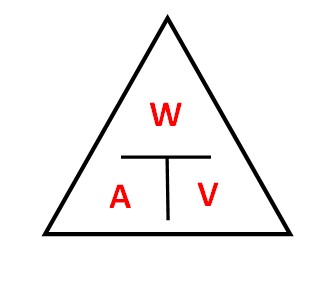Selecting LED Tape Power Supplies
LED Tape is typically available in 12v DC and 24v DC varieties. The power in a domestic property is 240V AC, so for a home installation you will require a power supply that converts the 240V to 12v or 24v DC.
All of our Lyyt LED Tape Kits include a suitable power supply that makes this conversion, and fully illuminates the enclosed 5m of LED Tape.
How do you power a custom LED Tape length?
Every LED Tape variant has its own power requirements. SMT (Surface Mounted Technology) Tape can be different to COB (Chip on Board) Tape, and single colour versus multicolour LEDs can require different amounts of power.
Don’t worry though – it is very easy to work out how much power you will need for your installation. All of the technical data you require will be on the LED Tape label/packaging, and if you are in doubt you can work it out using the diagram below:

• If you need to know the Power (W) then you multiply Current (A) by Voltage (V)
• If you need the Current (A) then you divide the Power (W) by the Voltage (V)
• If you need the Voltage (V) then divide the Power (W) by Current (A)
Example: 4 metres of 24v LED Tape, rated at 0.5A per metre.
• Take the current in Amps and multiply it by 24v, which equals 12W per metre.
• 4 meters multiplied by 12 is 48W, so you need a 24v 48W power supply.
What if I cannot find an exact Power Supply Unit (PSU) for my tape?
Don’t worry – it is perfectly safe to buy a power supply that exceeds your requirements. For our 48W PSU example above, a 24v 60W power supply would be perfectly fine.
Power supply wattage, amps and voltage can be confusing, and it is not unreasonable to assume that using a 60W PSU with 48W LED Tape will be dangerous. But just because a power supply is capable of delivering 60W, does not mean it will.
On the contrary, a power supply will match the requirements of whatever appliance it is attached to. Only if the power required exceeds that which the power supply can deliver, will you potentially damage your appliance.
Which voltage should I choose for my installation?
Often the price and performance of 12v and 24v may be so similar that there does not appear to be a difference. 12v power supplies are generally smaller when compared to 24v, so you might need to consider this when working on an installation with minimal space. 24v is much more efficient, so you can run twice the length of LED Tape using 24v as opposed to 12v without suffering a voltage drop.
For example, 24W per metre of LED Tape will draw 2A at 12v. The same LED Tape at 24v will draw just 1A. Both will produce the same amount of light output and are of equal wattage, but because the 24v is drawing less current it is more efficient and will perform better in the long term.
What is voltage drop?
This is where the LEDs in your tape gets noticeably dimmer towards the end of the tape length furthest from the power supply. This can happen with very long LED Tape installations. The resistance in the copper circuitry increases the further along the LED Tape length you are, thereby reducing the voltage reaching those LEDs at the end of the tape. Resistance also generates heat, which means longer lengths can be very inefficient and could cause problems if the installation is close to heat sensitive materials.
Typically the maximum single length of LED Tape you can run off a single power supply is 5m for 12v and 10m for 24v. Should you install for example a 30m length of LED Tape using a single power supply at one end, the tape will visibly dim towards the other end as demonstrated below:

How can I avoid voltage drop?
The best way to achieve a fully illuminated length of LED Tape longer than 10m is to have multiple runs within your installation. This is a much safer and more efficient way of achieving a longer installation. Simply have one maximum recommended length of LED Tape, and run a parallel power connection to the start of the next run and so on.

My installation requires a continuous length of LED Tape. Is this possible?
If you must have one continuous run of LED Tape longer than 10m, then you would need to split the output of the power supply to another cable, run it parallel to the LED Tape and join it to the opposite end so you are powering the tape from both ends. By using this method you are essentially creating a ring main.
If following this method, it is important that you choose the correct gauge of cable for the total length of LED Tape you are installing and the current you are running down it. Up to 10m, we would recommend 0.75mm2 and up to 20m 1mm2 2 core mains cable.

